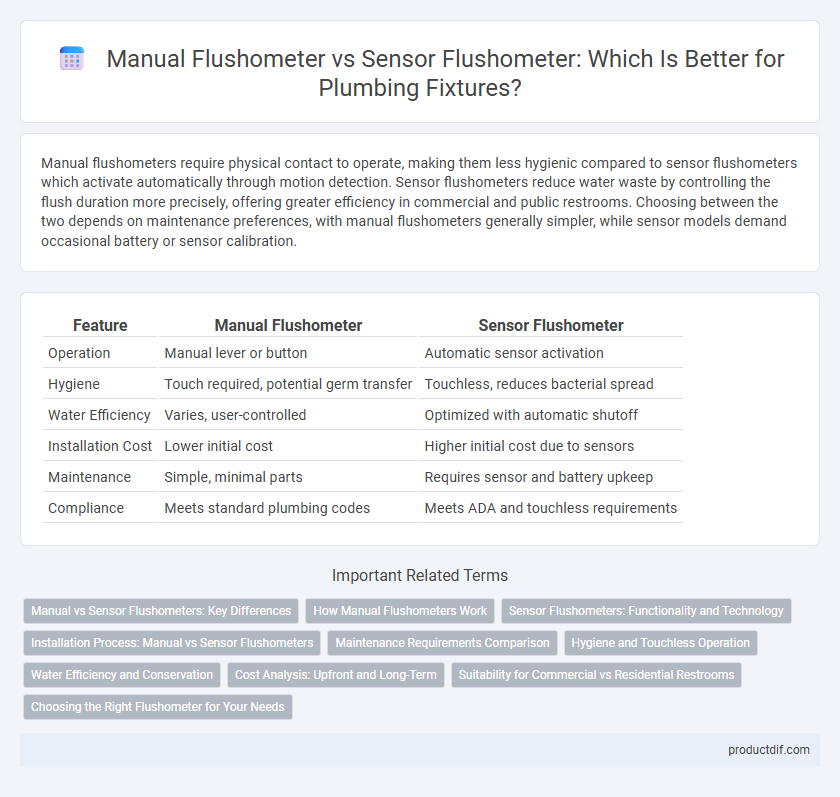Manual flushometers require physical contact to operate, making them less hygienic compared to sensor flushometers which activate automatically through motion detection. Sensor flushometers reduce water waste by controlling the flush duration more precisely, offering greater efficiency in commercial and public restrooms. Choosing between the two depends on maintenance preferences, with manual flushometers generally simpler, while sensor models demand occasional battery or sensor calibration.
Table of Comparison
| Feature | Manual Flushometer | Sensor Flushometer |
|---|---|---|
| Operation | Manual lever or button | Automatic sensor activation |
| Hygiene | Touch required, potential germ transfer | Touchless, reduces bacterial spread |
| Water Efficiency | Varies, user-controlled | Optimized with automatic shutoff |
| Installation Cost | Lower initial cost | Higher initial cost due to sensors |
| Maintenance | Simple, minimal parts | Requires sensor and battery upkeep |
| Compliance | Meets standard plumbing codes | Meets ADA and touchless requirements |
Manual vs Sensor Flushometers: Key Differences
Manual flushometers require direct physical activation, typically via a lever or push button, ensuring reliable water release but increasing the risk of germ transmission through contact. Sensor flushometers utilize infrared technology to detect user presence or hand movement, enabling touch-free activation that enhances hygiene and reduces water waste by controlling flush duration precisely. The choice between manual and sensor flushometers impacts maintenance frequency, installation complexity, and overall restroom user experience.
How Manual Flushometers Work
Manual flushometers operate through a handle or push button that releases a measured amount of water when activated, flushing the toilet or urinal. The handle triggers a diaphragm or piston mechanism inside the valve, which allows water to flow from the supply line into the fixture. This system relies on direct user interaction to initiate each flush, ensuring controlled water usage per flush cycle.
Sensor Flushometers: Functionality and Technology
Sensor flushometers utilize infrared or capacitive sensors to detect user presence, enabling touchless flushing that enhances hygiene and reduces water waste. These devices integrate advanced electronics and solenoids to control water flow precisely, ensuring efficient operation and compliance with water conservation standards like EPA WaterSense. Modern sensor flushometers often feature adjustable flush volumes and battery life indicators, optimizing maintenance and performance in commercial and public restrooms.
Installation Process: Manual vs Sensor Flushometers
Manual flushometers feature straightforward installation with basic plumbing connections and simple mechanical linkages, often requiring less wiring expertise. Sensor flushometers demand more complex installation, incorporating electrical wiring, sensor calibration, and potential power source integration for automatic operation. Proper alignment and sensitivity adjustments are critical for sensor models to ensure effective detection and water conservation.
Maintenance Requirements Comparison
Manual flushometers require regular cleaning and inspection of handles and internal components to prevent mechanical wear and leaks. Sensor flushometers demand more complex maintenance involving periodic battery replacements, sensor calibration, and troubleshooting electronic malfunctions. Both types benefit from routine valve and seal checks to ensure optimal water efficiency and longevity.
Hygiene and Touchless Operation
Sensor flushometers enhance hygiene by enabling entirely touchless operation, significantly reducing the risk of germ transmission compared to manual flushometers that require physical contact. The touchless technology in sensor flushometers activates flushing through infrared sensors, promoting a cleaner restroom environment and minimizing cross-contamination. Manual flushometers rely on handles or buttons, which can harbor bacteria and require frequent cleaning to maintain sanitary conditions.
Water Efficiency and Conservation
Manual flushometers require physical contact to operate, often leading to excessive water use due to prolonged flushing times. Sensor flushometers utilize infrared technology to detect user presence, enabling precise flush volumes and reducing water waste by activating only when necessary. This hands-free operation enhances water efficiency and supports conservation efforts in commercial and public restrooms.
Cost Analysis: Upfront and Long-Term
Manual flushometers generally have a lower upfront cost compared to sensor flushometers, making them a budget-friendly option for initial installation. Sensor flushometers, while more expensive initially, can lead to long-term savings through reduced water usage and decreased maintenance due to fewer mechanical parts. Evaluating total cost of ownership requires considering factors such as water efficiency, potential repair expenses, and energy consumption associated with sensor technology.
Suitability for Commercial vs Residential Restrooms
Manual flushometers are commonly preferred in commercial restrooms due to their durability, ease of maintenance, and cost-effectiveness in high-traffic environments. Sensor flushometers, offering touchless activation, enhance hygiene and reduce water waste, making them ideal for modern commercial spaces prioritizing user convenience and sanitation. Residential restrooms typically favor manual flushometers for their simplicity and lower initial cost, while sensor models are less common but growing as smart home technology adoption increases.
Choosing the Right Flushometer for Your Needs
Choosing the right flushometer depends on factors such as usage frequency, hygiene requirements, and budget. Manual flushometers offer reliability and cost-effectiveness with simple mechanical operation, ideal for low-traffic restrooms. Sensor flushometers enhance sanitation by enabling touchless activation, reduce water waste with automatic flush controls, and suit high-traffic or healthcare facilities prioritizing hygiene and water efficiency.
manual flushometer vs sensor flushometer Infographic

 productdif.com
productdif.com